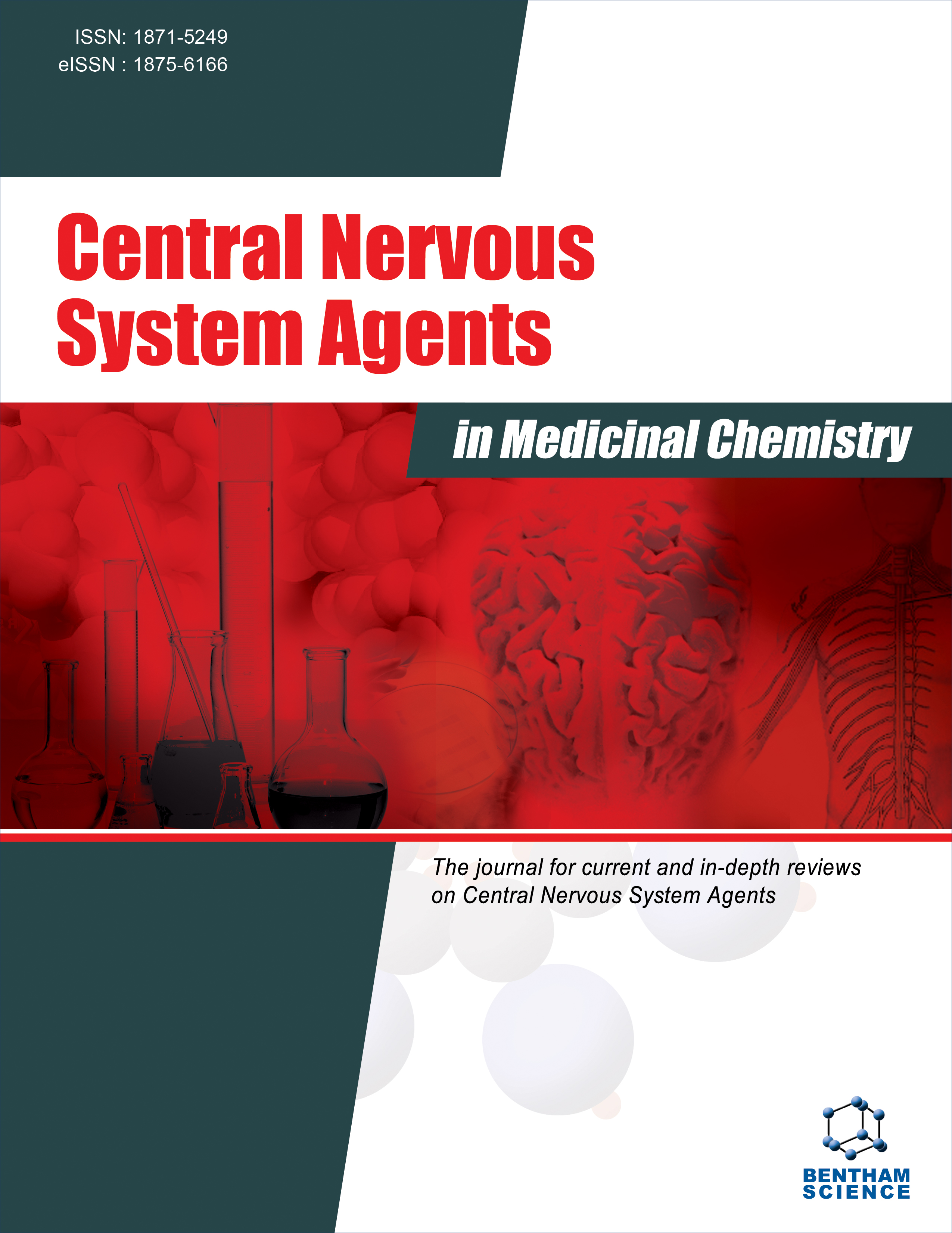- Home
- A-Z Publications
- Central Nervous System Agents in Medicinal Chemistry (Formerly Current Medicinal Chemistry - Central Nervous System Agents)
- Previous Issues
- Volume 11, Issue 2, 2011
Central Nervous System Agents in Medicinal Chemistry (Formerly Current Medicinal Chemistry - Central Nervous System Agents) - Volume 11, Issue 2, 2011
Volume 11, Issue 2, 2011
-
-
Editorial [Hot Topic: Recent Advances in Stroke: Molecular Mechanisms, Approaches, and Treatments (Guest Editor: Xin Wang)]
More LessBy Xin WangStroke, either ischemic or hemorrhagic, is the leading cause of adult disability and the second leading cause of death worldwide. According to The World Stroke Organization, one in six people alive today will at some time have a stroke, and every six seconds someone somewhere will die from a stroke. Therefore, the fight against stroke has been put at the top of the global health agenda, and having up-to-date information is cruc Read More
-
-
-
Central Nervous System Agents for Ischemic Stroke: Neuroprotection Mechanisms
More LessAuthors: Rachna S. Pandya, Lijuan Mao, Hua Zhou, Shuanhu Zhou, Jiang Zeng, A. John Popp and Xin WangStroke is the third leading cause of mortality and disability in the United States. Ischemic stroke constitutes 85% of all stroke cases. However, no effective treatment has been found to prevent damage to the brain in such cases except tissue plasminogen activator with narrow therapeutic window, and there is an unmet need to develop therapeutics for neuroprotection from ischemic stroke. Studies have shown that mecha Read More
-
-
-
Mitochondria: the Headquarters in Ischemia-Induced Neuronal Death
More LessAuthors: Joaquin Jordan, Piet W.J. de Groot and Maria F. GalindoDue to a lack of efficient treatments, searching for novel therapies against acute ischemic stroke represents one of the main fields in neuropharmacology. In this review we summarize and discuss the role of mitochondrial participation in ischemia-induced neuronal death. Mitochondria are regarded as the main link between cellular stress signals and the execution of programmed death of nerve cells. Since Read More
-
-
-
Involvement of Toll-like Receptors in Ischemia-induced Neuronal Damage
More LessAuthors: Junya Hamanaka and Hideaki HaraCerebral ischemia is characterized by obvious inflammatory cell aggregations, up-regulation of cytokine expression, and increased expression of intercellular adhesion molecules. Like systemic bacterial infections, cerebral injury is also associated with innate immunity, a specific immunologic response that utilizes Toll-like receptors (TLRs). The involvement of TLRs in cerebral ischemia is now being confirmed using animal mode Read More
-
-
-
Ras Family Small GTPase-Mediated Neuroprotective Signaling in Stroke
More LessAuthors: Geng-Xian Shi, Douglas A. Andres and Weikang CaiSelective neuronal cell death is one of the major causes of neuronal damage following stroke, and cerebral cells naturally mobilize diverse survival signaling pathways to protect against ischemia. Importantly, therapeutic strategies designed to improve endogenous anti-apoptotic signaling appear to hold great promise in stroke treatment. While a variety of complex mechanisms have been implicated in the pathogenesis of Read More
-
-
-
Therapeutic Application of Histone Deacetylase Inhibitors for Stroke
More LessAuthors: Lei Lv, Yu-Ping Tang, Xiang Han, Xin Wang and Qiang DongHistone deacetylases (HDACs) play a key role in the homeostasis of histone acetylation and gene transcription. Histone hypoacetylation and transcriptional dysfunction have been identified in a large number of neurological diseases, including ischemic and hemorrhagic stroke. HDAC inhibitors (HDACi) have emerged as a promising therapeutic intervention in neurodegenerative disorders. Here we review and discuss re Read More
-
-
-
Future Perspectives on the Fibrinolytic Therapy of Intracerebral Hemorrhages
More LessBy Ruth ThiexIntracerebral hemorrhage (ICH) is associated with a high mortality and severe disability. Whereas a classical open craniotomy for hematoma removal may further traumatize brain tissue, minimally invasive surgery combines benefits of surgical clot removal with limited tissue damage and shorter surgery duration. Evacuation is often hampered by clot retraction, thus, advocating clot liquefaction to facilitate complete evacu Read More
-
-
-
From Bone to Brain: Human Skeletal Stem Cell Therapy for Stroke
More LessBy Shuanhu ZhouHuman adult skeletal stem cells, a.k.a. mesenchymal stem cells or marrow stromal cells (MSCs), have been identified as precursors of several different mesenchymal cellular lineages, including osteoblasts, chondrocytes, myoblasts, adipocytes, and fibroblasts, as well as non-mesenchymal lineages including neurons and glial cells. Adult stem cell transplantation is a promising strategy for the treatment of stroke. MSCs are al Read More
-
-
-
Astrocytes: Targets for Neuroprotection in Stroke
More LessAuthors: George Barreto, Robin E. White, Yibing Ouyang, Lijun Xu and Rona G. GiffardIn the past two decades, over 1000 clinical trials have failed to demonstrate a benefit in treating stroke, with the exception of thrombolytics. Although many targets have been pursued, including antioxidants, calcium channel blockers, glutamate receptor blockers, and neurotrophic factors, often the focus has been on neuronal mechanisms of injury. Broader attention to loss and dysfunction of non-neuronal cell types Read More
-
Volumes & issues
-
Volume 25 (2025)
-
Volume 24 (2024)
-
Volume 23 (2023)
-
Volume 22 (2022)
-
Volume 21 (2021)
-
Volume 20 (2020)
-
Volume 19 (2019)
-
Volume 18 (2018)
-
Volume 17 (2017)
-
Volume 16 (2016)
-
Volume 15 (2015)
-
Volume 14 (2014)
-
Volume 13 (2013)
-
Volume 12 (2012)
-
Volume 11 (2011)
-
Volume 10 (2010)
-
Volume 9 (2009)
-
Volume 8 (2008)
-
Volume 7 (2007)
-
Volume 6 (2006)
Most Read This Month
Article
content/journals/cnsamc
Journal
10
5
false
en


